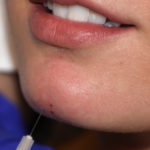Chin augmentation is one of the most facial augmentation procedures, both historically and to the present day. Chin implants are the most common method to achieve these changes and they are more successful than not in the vast majority of patients. Injectable methods of chin augmentation have come into play since the introduction of synthetic temporal fillers. Such fillers can be used as a temporary test of the effects of chin augmentation.
Fat injection grafting is the most popular method of soft tissue augmentation anywhere on the body today. Its use for hard tissue augmentation in the face, however, has been more limited with its most extensive use for cheek augmentation. Although injectable fat grafting has clearly been used all over the face but with limited critical analysis of its effectiveness.
In the December 2017 issue of the journal of Plastic and Reconstructive Surgery an article was published entitled ‘Prospective Controlled Study of Chin Augmentation by Means of Fat Grafting’. In this paper the authors evaluated forty-two (42) consecutive cases of chin augmentation by fat grafting over an 18 month period. A three-dimensional analysis was done to determine volume and gain in sagittal projection. All patients showed an increase in both sagittal projection and in total volume at one and six months after surgery. There was an average increase of almost 9mm in sagittal projection and with an average volume of almost 8mls.

Like all chin augmentation methods, each one has its advantages and disadvantages. No singe method is perfect and the patient must accept their tradeoffs. The long-term outcome of fat grafting to the chin as yet remains unknown.
Dr. Barry Eppley
Indianapolis, Indiana


